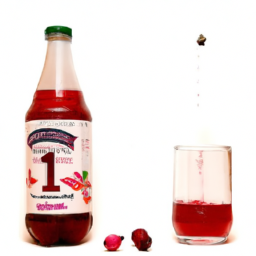Juice Tips and Tricks
How Long Does Cranberry Juice Last After Expiration Date
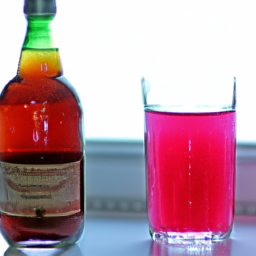
Imagine this situation: You’re searching through your pantry, searching for a refreshing drink to quench your thirst. You come across a bottle of cranberry juice tucked away in the back, but its expiration date has long passed. Do you risk drinking it and potentially experience health problems? Or do you dispose of it and contribute to the growing problem of food waste?
As a society, we’re constantly bombarded with expiration dates, causing us to question the safety and shelf life of our food and drinks. But how accurate are these dates, and how long can we actually consume products after they’ve expired?
In this article, we’ll explore the topic of expired cranberry juice, discussing its shelf life, proper storage techniques, signs of spoilage, health risks, and alternative uses.
So, let’s grab a glass and dive in!
Key Takeaways
- Expiration dates indicate quality, not safety.
- Proper storage can extend the shelf life of cranberry juice.
- Once opened, cranberry juice can last up to 7-10 days in the fridge.
- Expired cranberry juice can cause health issues, but it can still be used for cooking, baking, cleaning, and cocktails.
Understanding Expiration Dates
You may be wondering, "How long can I actually keep this cranberry juice after the expiration date?"Well, first off, let’s take a moment to understand what an expiration date really means.
Many people have common misconceptions about expiration dates, thinking that it’s an indication of when the product becomes unsafe to consume. However, it’s actually the date when the manufacturer can no longer guarantee the quality of the product. This means that the product may still be safe to consume beyond the expiration date, but the taste and texture may not be as good as it once was.
It’s important to note that consuming expired products can have an impact on the environment. When we throw away expired food and drinks, it contributes to the growing amount of waste in landfills. This waste not only takes up space, but it also releases harmful gases into the atmosphere.
By being mindful of expiration dates and properly storing and consuming products, we can reduce our impact on the environment.
Now, let’s move on to the next section about cranberry juice shelf life.
Cranberry Juice Shelf Life
If you’ve been wondering about the shelf stability of cranberry juice, rest assured that it can stay fresh and tasty for quite a while. The preservation techniques used during the manufacturing process help to extend the juice’s shelf life, making it last longer than other fresh juices.
The following are some key points to consider when it comes to cranberry juice’s shelf life:
-
Unopened cranberry juice can last up to 6 months beyond the printed expiration date.
-
Once opened, cranberry juice can last up to 7-10 days in the refrigerator.
-
Cranberry juice can also be frozen for up to 8 months.
-
The shelf life of cranberry juice can be extended by storing it in a cool, dry place away from direct sunlight.
Proper storage techniques are critical in maintaining the shelf life of cranberry juice. Understanding how to store your juice can help to ensure that it remains fresh and tasty for a longer period.
Proper Storage Techniques
To keep your cranberry juice fresh and delicious, it’s important to store it properly using these simple techniques.
First, temperature control is crucial. Cranberry juice should be kept in a cool, dark place away from direct sunlight and heat sources. Ideally, it should be stored at a temperature between 33 and 40 degrees Fahrenheit. This means that it should be kept in the refrigerator after it’s been opened.
If the juice is unopened, it can be stored in a pantry or other cool area until the expiration date.
Secondly, container options can also impact the shelf life of cranberry juice. It’s best to store cranberry juice in its original container, as it’s been specifically designed to keep the juice fresh. If the original container has been opened, it’s a good idea to transfer the juice to a clean, airtight container. This will help prevent exposure to oxygen, which can cause the juice to spoil faster.
By following these simple storage techniques, you can ensure that your cranberry juice stays fresh and delicious for as long as possible.
When it comes to signs of spoilage, there are a few things to look out for. If the juice has an off smell, flavor, or appearance, it’s likely that it’s gone bad. Additionally, if the container is bulging or leaking, it’s a sign that the juice has started to ferment and should not be consumed.
By being mindful of these signs, you can avoid drinking expired or spoiled cranberry juice.
Signs of Spoilage
Spotting signs of spoilage in your cranberry juice is crucial to ensure that you don’t consume expired or bad-tasting juice. Common contaminants that can affect the quality and safety of cranberry juice include bacteria, molds, and yeast. These microorganisms can multiply and thrive in the juice if it’s stored improperly, exposed to air or moisture, or left at room temperature for too long.
To check if your cranberry juice has gone bad, look for signs of spoilage such as changes in color, texture, and taste. The juice may develop a cloudy appearance, a sour or off taste, or a slimy texture. These are all indicators that the juice has been contaminated and is no longer safe for consumption.
Drinking expired cranberry juice can also pose potential health risks, which we will discuss in the next section.
Health Risks of Consuming Expired Cranberry Juice
Be aware that consuming expired cranberry juice can put you at risk for potential health issues, including food poisoning, stomach upset, and infections. Common misconceptions may lead people to believe that consuming expired cranberry juice is harmless, but this isn’t the case.
The expiration date serves as a warning that the product may no longer be safe for consumption due to potential contamination from bacteria or other harmful microorganisms.
Additionally, consuming expired cranberry juice may also lead to digestive problems and discomfort. It may also cause adverse reactions in individuals who have allergies or sensitivities to certain ingredients in the juice.
It’s always best to err on the side of caution and avoid consuming expired cranberry juice to prevent any potential health risks.
In the next section, we’ll discuss alternative uses for expired cranberry juice.
Alternative Uses for Expired Cranberry Juice
As I researched the health risks of consuming expired cranberry juice, I also discovered some alternative uses for it.
One way to use expired cranberry juice is in cooking and baking, as it can add a tangy flavor to dishes like marinades or vinaigrettes.
Additionally, expired cranberry juice can be used for cleaning and household purposes, such as removing stains or cleaning toilets.
Finally, there are creative ways to use leftover juice, such as making popsicles or adding it to cocktails.
Cooking and baking
When cooking and baking, it’s important to use fresh ingredients, but don’t worry too much if your cranberry juice has expired – it should still be good for a few days past the date. However, keep in mind that the expiration date is only a rough estimate of when the juice may start to lose its flavor and nutritional value.
Here are some cooking tips and baking hacks to help you make the most of your expired cranberry juice:
-
Use it as a marinade: Mix expired cranberry juice with olive oil, vinegar, and your favorite spices to create a flavorful marinade for meats, poultry, or vegetables.
-
Make a glaze: Use expired cranberry juice to create a sweet and tangy glaze for ham, chicken, or pork.
-
Add it to baked goods: Use expired cranberry juice instead of water or milk in your favorite bread, muffin, or cake recipe for added moisture and flavor.
-
Mix it into sauces: Add expired cranberry juice to your favorite tomato or barbecue sauce recipe for a unique twist on traditional flavors.
While expired cranberry juice can still be used in cooking and baking, it’s important to note that it may start to lose its quality over time.
In the next section, we’ll explore some other alternative uses for expired cranberry juice, including cleaning and household uses.
Cleaning and household uses
Moving away from cooking and baking, let’s now delve into the household applications of cranberry juice. As someone who is always looking for natural cleaning alternatives, I was pleasantly surprised to discover that cranberry juice can be used as a cleaning agent. Its acidic properties make it effective in removing stains and disinfecting surfaces.
To give you a better idea of how versatile cranberry juice can be in cleaning, here is a table of some of its household applications:
| Household Application | How to Use Cranberry Juice |
|---|---|
| Stain Remover | Apply cranberry juice to the stain, let it sit for 10 minutes, then blot with a damp cloth. |
| Toilet Cleaner | Pour 1 cup of cranberry juice into the toilet bowl and let it sit for an hour before scrubbing and flushing. |
| Dishwasher Cleaner | Pour cranberry juice into the dishwasher dispenser and run a cycle with hot water. |
| Glass Cleaner | Mix equal parts cranberry juice and water in a spray bottle and use it to clean glass surfaces. |
| Odor Neutralizer | Place a bowl of cranberry juice in the fridge or microwave to absorb unwanted odors. |
With these household applications, you can save money on cleaning products while also reducing your exposure to harmful chemicals. Now that we’ve explored the cleaning potential of cranberry juice, let’s move on to creative ways to use leftover juice.
Creative ways to use leftover juice
Get ready to discover some fun and unexpected ways you can use up that leftover cranberry juice sitting in your fridge. Don’t let it go to waste!
One idea is to use it in a recipe for cranberry sauce or jelly. Simply mix the juice with sugar and cook it down until it thickens. This is a great way to use up leftover juice from holiday gatherings or parties.
If you’re looking for something a little more festive, consider making cranberry juice cocktails. Mix the juice with vodka and a splash of lime juice for a delicious and refreshing drink. You can also add in other fruits like oranges or pomegranates for added flavor. With a little creativity, you can turn your leftover cranberry juice into a tasty treat that everyone will love.
As you finish up your last sip of cranberry juice, remember the importance of label reading. It’s important to check the expiration date on your juice before consuming it, as expired juice can lead to illness or other health problems. Always be sure to properly store and dispose of any leftover juice to prevent contamination.
Importance of Label Reading
When it comes to understanding product labeling, I find it important to pay close attention to the details. As a consumer, I want to ensure that the products I purchase are safe to consume and of good quality. By properly deciphering product labels, I can make informed decisions on whether a product is suitable for consumption. Additionally, I can determine how to store it correctly to maximize its shelf life.
To achieve this, it is important to identify expiration dates and interpret storage instructions. By doing so, I can make sure that the product is not expired and is stored in the proper conditions to maintain its quality. Overall, paying attention to product labeling is critical for ensuring the safety and quality of the products we consume.
Understanding product labeling
Understanding product labeling is crucial as it can help consumers avoid consuming expired products, which, according to a USDA study, can lead to foodborne illnesses affecting an estimated 48 million people annually in the US alone. Here are some important things consumers should know about product labeling:
-
Product labeling includes information about the product’s ingredients, nutritional value, origin, and manufacturer.
-
Labels also include important safety information, such as warnings and instructions for use.
-
Expiration dates can be found on most products and indicate when the product is no longer safe to consume.
-
Understanding product labeling requires consumer education and the ability to read and interpret the information provided.
Identifying expiration dates is an important step in ensuring that products are safe to consume. Consumers should be aware that different types of products may have different types of expiration dates, such as "best by"or "use by"dates. It’s important to check these dates before consuming any food or beverage to avoid any potential health risks.
Identifying expiration dates
To make sure you don’t end up consuming expired products, it’s important that you understand how to identify the expiration dates on different types of products. Most products have a clearly marked expiration date, while others have a code that needs to be deciphered.
Understanding expiration dates is crucial to ensure that you consume fresh and safe products. For products with a clear expiration date, it is usually printed on the label or packaging. It may be labeled as ‘best by,’ ‘use by,’ or ‘sell by.’ These dates indicate the date until which the product is expected to be of best quality or freshness.
For products with a code, it may be a combination of letters and numbers that represent the date of production or expiration. Deciphering these codes may require some research or contacting the manufacturer.
It is important to note that consuming expired products may result in food poisoning or illness, so always check the expiration date or code before consuming the product. Understanding expiration dates is just the first step in ensuring that you consume fresh and safe products.
Next, we will discuss how to interpret storage instructions to further extend the shelf life of your products.
How to interpret storage instructions
You probably already know how to store your food, but it’s important to understand how to interpret storage instructions to ensure proper handling and freshness. Most food products come with specific instructions for storage, which may include keeping them in a cool, dry place or refrigerating them at a specific temperature. It’s important to follow these instructions to avoid spoilage, which can lead to foodborne illnesses.
Proper handling of food products, like cranberry juice, is critical for maintaining their quality and safety. Cranberry juice typically comes with instructions for refrigeration, which means it should be stored at a temperature between 32°F and 40°F. This ensures that the juice stays fresh for the longest possible time and prevents the growth of harmful bacteria. By following these storage instructions, you can enjoy your cranberry juice for longer and minimize the risk of foodborne illnesses.
Now that we’ve covered the importance of proper storage, let’s move on to best practices for drinking cranberry juice.
Best Practices for Drinking Cranberry Juice
As someone who regularly drinks cranberry juice, it’s important to understand the recommended daily intake, the potential health benefits, and how to choose the right type of juice.
The daily recommended intake of cranberry juice is typically between 8-16 ounces per day. Studies have shown that drinking cranberry juice may help prevent urinary tract infections, reduce inflammation, and promote heart health.
When choosing a cranberry juice, it’s important to look for brands with no added sugars and to avoid juices with low cranberry content.
Daily recommended intake
Hey there, did you know that experts recommend drinking up to 8 ounces of cranberry juice per day as part of a healthy diet? This daily recommended intake offers a wide range of benefits for your body, including boosting your immune system, reducing inflammation, and improving your heart health.
However, it’s essential to be aware of the risks associated with excessive consumption, such as gastrointestinal issues and kidney stones. To ensure you’re getting the most out of your daily cranberry juice intake, it’s important to choose high-quality varieties and brands.
Look for options that are 100% pure cranberry juice with no added sugars or preservatives. Additionally, you may want to consider purchasing organic cranberry juice to avoid any potential exposure to harmful pesticides. Drinking 8 ounces of cranberry juice per day can provide numerous health benefits, but it’s crucial to consume it in moderation and choose high-quality options.
Now, let’s dive into the next section to explore the specific health benefits of cranberry juice.
Health benefits of cranberry juice
Did you know that drinking cranberry juice regularly can be beneficial for your health? Cranberry juice has been known to reduce the risk of urinary tract infections (UTIs) by up to 50%, thanks to its antibacterial properties.
UTIs are caused by bacteria attaching to the walls of the urinary tract, and cranberry juice prevents this attachment, making it harder for the bacteria to thrive. Besides its effects on UTIs, cranberry juice has also been linked to heart health.
The flavonoids in cranberries can improve blood pressure and reduce the risk of heart disease. Additionally, the antioxidants in cranberries can reduce inflammation and oxidative stress, which can also contribute to heart disease. So, incorporating cranberry juice into your diet can be a great way to promote overall health.
When it comes to choosing the right type of juice, it’s important to look for 100% pure cranberry juice, as many commercial brands contain added sugars and preservatives. Additionally, drinking too much cranberry juice can lead to stomach discomfort and diarrhea, so it’s important to consume in moderation.
Choosing the right type of juice
To ensure you are getting the most health benefits from your juice, it’s crucial to pay attention to the label and select a 100% pure option without any added sugars or preservatives. Juice selection plays a significant role in maximizing the nutritional value of your drink. It’s essential to choose a juice that suits your taste preferences while providing the nutrients you need.
When selecting juice, it’s important to consider the sugar content. Many brands of juice contain added sugars, which can have negative impacts on your health. Choosing a juice with no added sugar or preservatives will ensure that you are getting the most natural and nutritious option available. Additionally, consider the type of juice you are purchasing. For example, orange juice is high in vitamin C, while grapefruit juice is high in antioxidants. By selecting a juice based on your taste preferences and nutritional needs, you can maximize the benefits of your drink.
To minimize food waste, it’s essential to understand how to store and use your juice effectively.
Tips for Reducing Food Waste
So, to recap the key points about drinking cranberry juice, it’s important to check the expiration date and consume it within a few days after opening.
While cranberry juice has many benefits, it’s important to also consider safety precautions to avoid any risks of contamination.
With that said, it’s also important to highlight the significance of reducing food waste and practicing proper food safety measures to ensure that our food and beverages remain safe for consumption.
Recap of key points
Alright, let’s quickly go over the key points we’ve discussed so far about how long cranberry juice lasts after its expiration date. First of all, understanding the expiration date is crucial. The date printed on the bottle indicates the last day that the product is guaranteed to be at its highest quality. However, it does not necessarily mean that the juice is unsafe to consume after that date.
To determine whether cranberry juice is still safe to drink after its expiration date, you should use your senses. Look for any signs of spoilage, such as mold or an off smell, and taste a small amount to see if it still tastes normal. If you notice any unpleasant changes, it’s best to discard the juice. To help you remember these points, here’s a table:
| Key Points Recap | Expiration Date Understanding | Sensory Check |
|---|---|---|
| Use by date is a guarantee of quality | Expiration date is not a safety date | Look for signs of spoilage |
| Expired juice may still be safe to drink | Use your senses to determine freshness | Taste a small amount for normal flavor |
Understanding the expiration date and using your senses to check the freshness of cranberry juice are essential for its safety. Now, let’s move on to the next section and discuss final thoughts on cranberry juice safety.
Final thoughts on cranberry juice safety
Now, let’s discuss some final thoughts on the safety of drinking expired cranberry juice. As with any expired food or beverage, there are both benefits and risks to consider.
On the one hand, consuming expired juice can lead to negative side effects such as upset stomach, diarrhea, or even food poisoning. On the other hand, many studies have shown that some expired juices, including cranberry juice, may still be safe to consume if they have been stored properly and are only a few days past the expiration date.
When it comes to cranberry juice specifically, research has shown that the antimicrobial properties of the juice can help to prevent bacterial growth and spoilage, even after the expiration date has passed. However, it’s important to note that the longer the juice sits past its expiration date, the greater the risk becomes for harmful bacteria to develop.
In general, it’s always best to err on the side of caution and dispose of any expired juice to avoid potential health risks. This not only ensures your safety but also helps to reduce food waste and promote overall food safety practices.
As we’ve seen, the safety of consuming expired cranberry juice is a complex issue with both benefits and risks to consider. By staying informed about the latest research and studies, we can make more informed decisions about our food choices and reduce waste while promoting food safety practices.
With this in mind, let’s now move on to the next section and explore the importance of food safety and waste reduction.
Importance of food safety and waste reduction
Now that we’ve established the safety concerns surrounding expired cranberry juice, let’s take a moment to discuss the broader issue of food safety and waste reduction.
As someone who’s worked in the food industry for years, I can’t stress enough how important it is to follow basic food safety tips in order to prevent illness and reduce waste.
One of the simplest ways to ensure food safety is by properly storing and handling perishable items. This includes keeping your refrigerator at the correct temperature (below 40°F), using separate cutting boards for raw meats and produce, and always washing your hands before handling food.
Additionally, reducing waste at home not only helps the environment, but it can also save you money. Plan your meals ahead of time, freeze leftovers for later use, and only purchase what you know you’ll consume.
By taking these small steps, we can all do our part to promote food safety and reduce waste in our homes.
Frequently Asked Questions
Can I still drink cranberry juice after it has expired?
Consuming expired cranberry juice can lead to negative health repercussions such as stomach upset and food poisoning. It’s best to avoid drinking expired juice and opt for alternatives such as fresh cranberry juice or water.
How long can I keep cranberry juice in the fridge after opening it?
After opening, cranberry juice should be stored in the fridge and consumed within 7-10 days. To extend its shelf life, keep it in an airtight container and avoid exposing it to light. Proper storage can help maintain its freshness and flavor. Storing tips are important for ensuring that cranberry juice remains safe and enjoyable to drink. If cranberry juice develops an off smell, flavor, or appearance, it should be discarded, as these may be signs of spoilage. The cranberry juice shelf life in fridge can be maximized by keeping it at a consistently cold temperature and away from temperature fluctuations. For best results, always check the juice before drinking to ensure it is still fresh.
Can I freeze cranberry juice to extend its shelf life?
Did you know that cranberry juice can last up to six months in the freezer? Freezing cranberry juice is a great way to extend its shelf life. To ensure optimal quality, follow these cranberry juice storage tips.
What is the difference between cranberry juice and cranberry cocktail?
When comparing cranberry juice to cranberry cocktail, the nutritional value differs greatly. Juice is typically made solely from cranberries, while cocktail contains added sweeteners and other juices. Taste-wise, juice is tart and tangy, while cocktail is sweeter.
Is it safe to drink cranberry juice every day?
Drinking cranberry juice every day can provide many health benefits, such as preventing UTIs and promoting heart health. However, excessive consumption can lead to risks such as stomach upset and kidney stones.
Conclusion
In conclusion, it’s important to understand the expiration date of cranberry juice and how to properly store it to ensure its longevity.
While most cranberry juice can last up to 6 months after its expiration date, it’s crucial to check for signs of spoilage before consuming it. Expired cranberry juice may cause health risks, so it’s best to avoid drinking it past its expiration date.
However, if you do find yourself with expired cranberry juice, don’t let it go to waste. It can be used for alternative purposes such as cleaning or cooking.
Remember to always read labels carefully and follow best practices for drinking cranberry juice. By taking these steps, you can reduce food waste and ensure the safety of your consumption.
Susannah expertise lies in researching and compiling evidence-based content on juicing, nutrition, and overall health. She is committed to ensuring that The Juicery World offers accurate, up-to-date, and trustworthy information to empower readers to take control of their health. Susannah’s goal is to inspire individuals to embrace juicing as a way to nourish their bodies and live their best lives.
Juice Tips and Tricks
How Do You Know When Pocket Juice Is Fully Charged

As a frequent user of electronic devices, I understand the significance of having a dependable power supply accessible constantly. This is why I decided to purchase a pocket juice – a compact portable charger that offers additional battery power while I am out and about. Nevertheless, due to the abundance of various models on the market, it can be challenging to ascertain precisely when my pocket juice is completely charged and prepared for usage.
Fortunately, there are several ways to ensure that your pocket juice is fully charged and ready to go when you need it. From checking the LED indicator to using a multimeter, there are a variety of methods that you can use to ensure that your pocket juice is fully charged and ready to use.
In this article, we’ll explore some of the most effective methods for determining when your pocket juice is fully charged, so that you can stay connected and powered up no matter where you go.
Key Takeaways
- Check the LED indicator for charging status: green light indicates a fully charged battery, red light means it’s still charging, and a flashing light indicates low battery or charging in progress.
- Observe the charging behavior for indication of a fully charged status: the LED light changes or blinks as the battery fills up, and a solid LED light means it’s fully charged.
- Avoid unplugging the device before the charging process is complete to prevent incomplete charging and battery damage.
- Use a high-quality charger specifically designed for the device and avoid third-party chargers to ensure pocket juice longevity and safety.
Understanding the Importance of Charging Your Pocket Juice
You gotta make sure you charge your pocket juice fully, or you’ll be stuck with a dead battery when you need it most. As we become increasingly reliant on our smartphones, tablets, and other electronic devices, it’s important to have a backup power source handy.
This is where portable power banks, such as pocket juice, come in handy. They’re small, lightweight, and can provide an extra boost of power to your device when you need it.
However, it’s important to note that not all power banks are created equal. The charging speed of your pocket juice can be affected by several factors, such as the capacity of the battery, the power output of the charger, and the number of devices being charged at the same time.
To ensure that your pocket juice is fully charged and ready to go, it’s important to use a high-quality charger and avoid charging multiple devices simultaneously. With that being said, let’s move on to the next step: checking the LED indicator.
Check the LED Indicator
When I charge my Pocket Juice, I always check the LED indicator to make sure I know when it’s fully charged.
The green light means the device is fully charged and ready to use. The red light indicates that the device is still charging, while a flashing light indicates a low battery and the need for a recharge.
It’s important to pay attention to the LED indicator to ensure that your Pocket Juice is always ready to go when you need it.
Green Light
As soon as the green light pops up on the pocket juice, it’s like the sun breaking through the clouds after a storm. It lets you know that it’s fully charged and ready to go. The green light meaning is the charging completion indication, and it’s an essential feature of the pocket juice.
It indicates that the battery has reached its maximum capacity and that it’s time to unplug it from the power source. However, it’s important to note that not all pocket juice models have a green light. Some models have a red light that turns off when it’s fully charged.
The red light indicates that the battery is charging, and when it goes off, it means that the pocket juice is fully charged. In the subsequent section about the ‘red light,’ we’ll discuss how to know when the pocket juice is charging and when it’s fully charged.
Red Light
Upon observing the red light on my pocket juice, I know that it’s in the process of charging. However, it’s important to understand that the red light doesn’t necessarily indicate that the battery is fully charged. It could just mean that the charging process has begun, and it’s important to be patient and allow the device to charge fully.
To determine if my pocket juice is fully charged, I usually check the voltage using a multimeter. This provides a more accurate reading of the battery’s charging status. Additionally, I also pay attention to the charging speed. If the charging speed slows down significantly, it could be an indication that the battery is almost fully charged.
Moving on to the subsequent section about the flashing light, it’s important to note that this is a common feature on pocket juice devices. It usually indicates a low battery level or that the device is in the process of charging.
Flashing Light
The flashing light on my portable charger always catches my attention, indicating a low battery level and reminding me to recharge before it’s too late. But it’s not just a warning sign – the flashing light on my pocket juice also serves as a charging indicator.
When I plug in my device to charge, the light will start flashing to let me know that the charging process has begun.
Here are some things to keep in mind when you see the flashing light on your pocket juice:
- The flashing light means that the charging process has started and is in progress.
- The light will stop flashing once the device is fully charged.
- It’s important not to unplug your device before the light stops flashing, as this could damage your battery.
- If the flashing light continues even after a few hours of charging, there may be an issue with your charger or device.
Now that you know what the flashing light on your pocket juice means, it’s important to also look for charging time details to ensure that your device is fully charged and ready to use.
Look for Charging Time Details
To determine when my pocket juice is fully charged, I simply check the charging time details and ensure that it’s been plugged in for the recommended amount of time.
It’s important to understand that factors affecting charging time include the size of your battery, the capacity of your charger, and the condition of your charging cable.
To avoid common charging mistakes and ensure that your pocket juice is fully charged, be sure to use the charging cable that came with your device, keep your battery and charger at room temperature, and avoid charging it in direct sunlight or near other sources of heat.
By following these guidelines, you can ensure that your pocket juice is fully charged and ready to use when you need it. Additionally, it’s important to keep your pocket juice stored in a cool, dry place to prolong its overall lifespan and prevent damage. Unlike perishable items with a limited shelf life, such as the shelf life of carrot juice, portable power banks can last significantly longer when properly maintained. Regularly checking the charge level and recharging as needed will further ensure optimal performance.
However, if you want to be absolutely certain that your device is fully charged, you can use a multimeter to measure the voltage of your battery. This will give you an accurate reading of the battery’s charge level, and you can rest assured that your pocket juice is ready to go.
Use a Multimeter
If you’re looking for an accurate way to check the charge level of your pocket juice, using a multimeter is a reliable method. Multimeters are used for measuring voltage, testing continuity, and are commonly used for troubleshooting and repairs.
To check the level of charge in your portable battery, set the multimeter to measure DC voltage. Then, touch the red multimeter lead to the positive terminal of the battery and the black lead to the negative terminal. The voltage reading on the multimeter will indicate the current level of charge in the battery.
Using a multimeter to check the charge level of your pocket juice is a technical and precise method. It allows you to get an accurate reading of the battery’s charge level. Once you know the level of charge in your portable battery, you can decide whether to continue charging it or unplug it from the power source.
In the next section, we’ll explore another method to check the battery level on your device.
Check the Battery Level on Your Device
Before checking the battery level on your device, it’s important to ensure that your device is compatible with the type of pocket juice charger you’re using. Some chargers may not be compatible with certain devices, which can cause issues when trying to charge your device.
If you’re experiencing any issues while trying to charge your device with a pocket juice charger, there are a few troubleshooting steps you can take. First, make sure that the charging cable is securely connected to both the charger and your device. If this doesn’t resolve the issue, try using a different charging cable or charger to see if the problem is with the cable or charger itself.
Once you’ve confirmed that your device is compatible and there are no issues with the charging cable or charger, you can then check the battery level on your device to ensure it’s fully charged. Observing the charging behavior can also give you an idea of whether or not your device is fully charged.
Observe the Charging Behavior
While checking the battery level on your device is one way to determine if your pocket juice is fully charged, it’s not always accurate. To truly know if your power bank is ready to go, you need to observe its charging behavior and analyze the results.
When you plug in your pocket juice, pay attention to the LED lights or any other indicators that show it’s charging. As time passes, you’ll notice the lights change or blink, which is a sign that the battery is filling up. Once the lights stop blinking and remain a solid color, that’s a good indication that your pocket juice is fully charged.
You can also test it out by unplugging it and seeing how long it lasts before it needs to be charged again.
Using a charging app can also help you keep track of your pocket juice’s charging progress and battery level. With these apps, you can monitor how long it takes to charge, how much power is left, and even get alerts when it’s time to charge. But before we dive into that, let’s explore some other ways to determine if your pocket juice is fully charged.
Use a Charging App
To make sure I always have a full tank of power, I find that using a charging app is the most convenient way to monitor my pocket juice’s charging status. The benefits of using a charging app are extensive.
Firstly, it provides an accurate measurement of the remaining battery life of my power bank, which allows me to plan my device charging accordingly. Secondly, the app is compatible with different devices, such as smartphones and tablets, which gives me the flexibility to use it with all my gadgets. Lastly, the app also offers valuable information about the charging speed, ensuring that I am aware of how long it will take to fully charge my pocket juice.
By using a charging app, I can keep track of my pocket juice’s charging progress without any guesswork. However, I should also consider getting a power bank with auto shut-off to prevent overcharging and damage to my devices.
Consider Getting a Pocket Juice with Auto Shut-off
If you want to protect your devices from overcharging, consider getting a pocket juice with auto shut-off. This feature ensures that your device is not overcharged, which can damage the battery life and performance. The auto shut-off function will automatically stop charging once your device is fully powered up, preventing any further damage or wear and tear on your battery.
There are both pros and cons of auto shut off for pocket juice. The main advantage is the protection it provides for your devices, ensuring that they are not overcharged and that the battery life is preserved. However, one potential disadvantage is that it may take longer to charge your devices since the charging process will be interrupted once it reaches full capacity.
When comparing different brands of pocket juice with auto shut off, it is important to consider the overall quality and reliability of the product, as well as the specific features and functions that are available.
By using a pocket juice with auto shut-off, you can ensure that your devices are charged safely and efficiently. However, it’s also important to avoid overcharging by monitoring your device’s battery level and unplugging it once it reaches full capacity.
Avoid Overcharging
When it comes to charging my devices, I always make sure to avoid overcharging. Overcharging can lead to serious risks, such as damage to the battery or even a fire hazard.
To prevent overcharging, I follow a few simple steps. I set a timer to monitor charging time and avoid charging my devices overnight. By taking these precautions, I can ensure the longevity and safety of my devices.
Risks of Overcharging
You don’t want to risk overcharging your pocket juice and damaging the battery. Overcharging occurs when you continue to charge your device after it has reached its maximum capacity. This can lead to several risks that can damage your pocket juice and even pose a risk to your safety.
Here are some precautions to keep in mind to avoid the risks of overcharging:
-
Reduced Battery Life: Overcharging shortens the battery life of your pocket juice. This means that the battery won’t last as long as it should have, and you’ll need to replace it sooner than you expected.
-
Fire Hazard: Overcharging can cause your pocket juice to overheat and even explode. This is because the lithium-ion battery inside the pocket juice contains flammable material that can ignite when exposed to heat or pressure.
-
Performance Issues: Overcharging can also cause your pocket juice to malfunction. This means that your device may not perform as well as it should, and you may experience issues such as slow charging or slow performance.
To prevent these risks, it’s important to know how to prevent overcharging.
How to Prevent Overcharging
By properly monitoring the charging process and unplugging the device once it reaches 100%, you can ensure the longevity and safety of your pocket juice. Preventing overcharging is crucial to avoid any damage to the device and potential safety hazards.
One of the common causes of overcharging is leaving your device plugged in overnight or for extended periods of time. It’s important to avoid this and keep an eye on the charging process.
Another tip to prevent overcharging is to use a charger specifically designed for your device. Using a charger with the wrong voltage or amperage can lead to overcharging and damage to your pocket juice. Also, it’s recommended to avoid using third-party chargers since they may not be compatible with your device.
Lastly, it’s crucial to keep your device and charging port clean and free from dust and debris. This ensures a proper connection and prevents any interruptions in the charging process. By following these tips and tricks, you can prevent overcharging and ensure the longevity and safety of your pocket juice.
Frequently Asked Questions
What is a pocket juice?
Pocket juice is a portable charging device designed to provide on-the-go power. As part of the broader category of portable chargers, there are several types and brands available. The best pocket juice brands ensure reliable, efficient charging, making them a convenient tool for anyone who needs to charge their devices while away from an outlet.
How long does it take to fully charge a pocket juice?
Charging speed of a Pocket Juice varies depending on factors such as its capacity and charging source. To maximize charging efficiency, use a high-quality charger and avoid using the device while charging.
What is the capacity of a typical pocket juice?
Pocket juice capacity varies depending on the model, ranging from 2,000mAh to 20,000mAh. This determines how much charge it can hold and how long it can power a device.
Can pocket juice be charged while in use?
Pocket Juice can be safely charged while in use, provided the device being charged is compatible with the Pocket Juice’s output. It’s important to follow the manufacturer’s guidelines for usage and charging to ensure safety.
How do you know when it’s time to replace your pocket juice?
When my Pocket Juice fails to hold a charge or takes longer to charge, it’s a sign of wear. According to Statista, the average lithium-ion battery lasts 2-3 years. Battery replacement or alternative charging options are available.
Conclusion
In conclusion, knowing when your pocket juice is fully charged is crucial, especially when you’re on the go and need to rely on your device for communication or other important functions. The most reliable way to determine if your pocket juice is fully charged is by checking the LED indicator, looking for charging time details, or using a multimeter. Additionally, observing the charging behavior, using a charging app, or considering getting a pocket juice with auto shut-off can also help ensure that your device is fully charged and ready to use.
Interestingly, research shows that the average person spends over 3 hours per day on their smartphone, which amounts to approximately 1,095 hours per year. With such heavy usage, it’s no surprise that having a reliable charging source like a pocket juice is essential. By following the tips outlined in this article, you can ensure that your pocket juice is fully charged and ready to keep up with your busy lifestyle.
Remember to avoid overcharging and always prioritize the safety of your device and yourself.
Cindy thoroughly researches juicing trends, techniques, and recipes to provide readers with practical advice and inspiration. Her writing style is accessible, engaging, and designed to make complex concepts easy to understand. Cindy’s dedication to promoting the advantages of juicing shines through her work, empowering readers to make positive changes in their lives through the simple act of juicing.
Juice Tips and Tricks
How Much Juice From 1 Lime
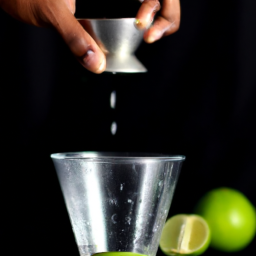
I have always been curious about how much juice can be extracted from a single lime, especially since I enjoy cooking and making drinks at home. It can be annoying when a recipe calls for a specific amount of lime juice, only to realize that the lime you have doesn’t produce enough juice. What’s equally perplexing is that the juice output can vary significantly based on the freshness, size, and type of lime. I often ponder how much juice is typically expected from one lime, as some limes appear to be more juicy than others. To prevent any frustration, I now make sure to buy a few extra limes, just in case.
In this article, I will explore the factors that affect the amount of juice in a lime and provide techniques for maximizing juice yield. The amount of juice in a lime can vary depending on factors such as size, ripeness, and juiciness. It can be difficult to predict how much juice you will get from a lime, but with a few tips and tricks, you can increase your chances of getting the most juice possible.
In the following sections, I will explain how to choose the right lime, how to prepare it for juicing, and techniques for hand and electric juicing. I will also provide tips for maximizing juice yield and creative ways to use leftover lime juice.
Key Takeaways
- The amount of juice yielded from a lime can be affected by various factors such as ripeness, temperature, and lime variety.
- Choosing the right lime variety is crucial for flavor and key limes are known to produce more juice than Persian limes.
- Hand squeezing yields more juice than using a juicer and rolling, microwaving, and using a citrus juicer or fork can help maximize juice yield.
- Lime juice is not only commonly used in cocktails, marinades, dressings, and desserts but is also a good source of vitamin C and antioxidants and has various health benefits such as aiding digestion and reducing inflammation.
Factors that Affect the Amount of Juice in a Lime
Do you ever wonder why some limes produce more juice than others? Well, it all comes down to factors affecting lime juice yield.
Among these factors, the ripeness of the lime plays a crucial role. A ripe lime will be softer and more pliable than an unripe one, making it easier to extract the juice. Moreover, a ripe lime will be heavier and have a thinner skin than unripe limes, which means it contains more juice.
Another factor that can impact the amount of juice in a lime is temperature. For instance, if you store limes in the refrigerator, they will produce less juice than those stored at room temperature. This is because cold temperatures slow down the metabolic processes in the fruit, making it harder to extract the juice.
Additionally, the variety of lime you’re using can also impact the juice yield. For instance, Key limes are known for producing more juice than Persian limes.
Now that we’ve established the factors that affect lime juice yield, let’s move on to some tips for getting the most juice from a lime.
How to Choose the Right Lime
Choosing the right lime is crucial for achieving the perfect flavor in your dish or drink. Here are three things to consider when selecting the best lime:
-
Varieties comparison: Not all limes are created equal. The two most common types of limes are Persian and Key limes. Persian limes are larger and have a thicker skin, making them easier to juice. Key limes, on the other hand, are smaller and have a thinner skin, but they’re more acidic and have a more complex flavor. Consider the type of dish or drink you’re making and choose the lime variety that’ll complement it the best.
-
Best storage methods: Limes can be stored at room temperature or in the refrigerator. However, it’s important to keep them away from direct sunlight and moisture, as this can cause them to spoil faster. When selecting limes, look for ones that are firm and have a vibrant green color. Avoid limes that’re soft or have brown spots, as they may be overripe and have less juice.
-
Organic or conventional: When choosing limes, consider whether you want to buy organic or conventional. Organic limes’re grown without pesticides and’re considered to be healthier for you and the environment. However, they may be more expensive than conventional limes. Ultimately, the choice’s up to you and your personal preferences.
To ensure you get the most juice out of your lime, it’s important to properly prepare it before juicing.
How to Prepare Your Lime for Juicing
Before squeezing your lime, it’s essential to cut it in a specific way to get the most out of its flavor. Knife techniques can vary depending on the type of lime you have. For example, Persian limes have a thinner rind and more juice than Key limes, which have a thicker rind and less juice.
To prepare your lime for juicing, first, wash it thoroughly under cold water. Next, cut off both ends of the lime to expose the flesh. Then, cut the lime in half lengthwise, making sure to cut through the center of the lime. Finally, cut each half into quarters, making sure to avoid the white pith, which can be bitter. Check out the table below for a visual guide on how to cut your lime for maximum juice extraction.
| Cut | Image |
|---|---|
| Cut both ends of the lime |  |
| Cut the lime in half lengthwise |  |
| Cut each half into quarters |  |
Now that you know how to prepare your lime for juicing, let’s move on to the hand juicing technique.
Hand Juicing Technique
To get the most out of your lime, I suggest using the hand squeezing technique. Although using a juicer may seem like a quicker and easier option, it can actually lead to less juice extracted from the fruit.
When you hand squeeze the lime quarters, you are able to apply more pressure and control over the amount of juice being extracted. This results in a higher yield of juice and a more efficient use of the lime.
In addition to maximizing the amount of juice extracted, hand squeezing also offers the benefits of fresh lime juice over bottled juice. Fresh lime juice contains more flavor and nutrients compared to bottled juice, which often contains added sugars and preservatives.
By using the hand squeezing technique, you can enjoy the full flavor and health benefits of the lime in your drinks and dishes. Now, if you prefer a quicker method, let’s move onto the electric juicing technique.
Electric Juicing Technique
When it comes to juicing limes, I’ve found that using an electric juicer is the most efficient method. It’s quick, easy, and produces a high yield of juice with minimal effort.
If you don’t have an electric juicer, using a blender or food processor can also get the job done, but it may require a bit more effort and produce a slightly lower yield.
Use an Electric Juicer
If you’re feeling lazy, grab an electric juicer to easily extract all the juice from your lime. This method doesn’t require a lot of effort and is great for juicing efficiency. Plus, you won’t have to worry about any equipment maintenance since the juicer does all the work.
Using an electric juicer is a great option when you’re in a rush or simply don’t want to bother with squeezing a lime by hand. However, if you’re looking for a thicker consistency or have a lot of pulp to work with, you may want to consider using a blender instead.
Use a Blender
Blend your way to a refreshing and smooth lime drink by using a blender, which can help you achieve a velvety consistency perfect for your summer cocktail. To start, cut your lime into quarters and remove the seeds. Add the lime quarters into the blender, along with a tablespoon of sugar and a cup of water. Pulse the blender a few times to break down the lime pieces, and then blend on high speed for 30 seconds to a minute until the mixture is smooth.
Blender techniques can vary depending on the brand and model of the blender. Some blenders may require more water to achieve the desired consistency, while others may require less. Alternatively, you can also add ice cubes to the blender to create a frozen lime drink. Experiment with different blender techniques and alternative methods until you find the perfect combination that suits your taste. Moving forward, let’s explore how to use a food processor to extract juice from a lime.
Use a Food Processor
With the help of a food processor, you can whip up a tangy lime concoction that will make your taste buds dance. While blenders are a go-to for many, there are food processor alternatives that can be just as effective.
The benefits of using a food processor for juicing include the ability to quickly and efficiently extract the juice without having to strain it through a mesh sieve. This method also allows you to control the texture of the juice, whether you prefer it smooth or with a bit of pulp.
Another advantage of using a food processor is that it can handle larger quantities of fruit at once, saving you time and effort. Simply cut the limes into quarters and pulse them in the food processor until they are fully broken down. Then, place the mixture into a fine mesh strainer and press down with a spoon to extract all of the juice.
With these tips in mind, you’ll be able to maximize the yield of your lime juice in no time.
Tips for Maximizing Juice Yield
To get the most juice from your lime, you should firmly roll it on the counter before cutting it open. This action helps break down the membranes inside the lime, making it easier to extract the juice. Additionally, try microwaving the lime for a few seconds before juicing it to help loosen the juice.
Another tip for maximizing juice yield is to use a citrus juicer or a fork to extract the juice. When using a citrus juicer, place the lime half cut-side down and press the handles together to extract the juice. When using a fork, simply insert it into the lime half and twist it back and forth to release the juice. By using these methods, you can get more juice out of each lime, making it easier to incorporate lime juice into your favorite recipes.
When you’re done juicing your lime, you may be wondering how to store any leftover juice. One way to do this is to freeze the juice in an ice cube tray. Once the cubes are frozen, transfer them to a freezer-safe bag and store them in the freezer for up to six months. This is a great way to have fresh lime juice on hand whenever you need it for a recipe.
How to Store Leftover Lime Juice
Don’t let that leftover lime juice go to waste! Here’s how you can store it for future use and keep your taste buds satisfied.
Storing lime juice can be a bit tricky as it tends to oxidize quickly, resulting in a sour taste and bitter flavor. But, with a few simple steps, you can preserve the lime juice’s freshness and flavor for an extended period.
Here are four ways to store leftover lime juice and prevent oxidation:
-
Transfer the lime juice into an airtight container and seal it tightly.
-
Store the container in the refrigerator and keep it away from direct sunlight.
-
Add a pinch of salt to the lime juice before storing it. This helps to slow down the oxidation process.
-
Use a clean spoon or measuring cup to scoop out the amount of lime juice you need. This prevents contamination and helps to keep the remaining juice fresh for longer.
With these simple steps, you can ensure that your leftover lime juice stays fresh and flavorful for future use.
Now that you’ve stored your lime juice, let’s move on to some creative ways to use it in your cooking!
Creative Uses for Lime Juice
I love finding creative uses for leftover lime juice, and these three ideas are some of my favorites.
Adding lime juice to cocktails or mocktails can give them a refreshing citrus twist.
Using it in salad dressings or marinades can add a bright, tangy flavor to your dish.
And adding it to salsas or guacamole can take the flavor to the next level.
Give these ideas a try the next time you have some leftover lime juice to use up.
Add to Cocktails or Mocktails
Drizzle a bit of freshly squeezed lime juice into your favorite cocktail or mocktail for a burst of tangy flavor. Lime juice is a popular ingredient in many drinks, especially those that call for a little bit of citrus. Here are three ways to incorporate lime juice into your next drink:
-
Use it in a margarita: A classic margarita recipe typically calls for lime juice, tequila, and triple sec. To make it, mix the ingredients together in a shaker with ice and pour it into a salt-rimmed glass. Add a lime wedge for garnish and enjoy!
-
Add it to a mojito: Mojitos are refreshing cocktails that are perfect for a hot summer day. To make one, muddle a few mint leaves with lime juice and sugar in a glass. Add rum and ice, then top it off with club soda. Garnish with a sprig of mint and a lime wedge.
-
Make a paloma: A paloma is a tequila-based cocktail that’s similar to a margarita, but with grapefruit juice instead of triple sec. To make it, mix tequila, grapefruit juice, lime juice, and a splash of soda water in a glass. Serve it over ice with a salt rim and a lime wedge.
Now that you know how to add lime juice to your cocktails, let’s talk about how it can be used in salad dressings or marinades.
Use in Salad Dressings or Marinades
Transform your salads and meats with the zesty tang of lime – perfect for adding an extra kick to your favorite dressings and marinades. Lime juice is a versatile ingredient that can be used on its own or mixed with other citrus fruits to create a unique taste. Experimenting with different acidities can help you find the perfect balance for your dish.
When making a salad dressing, try mixing lime juice with olive oil, honey, and Dijon mustard. This combination will give your dressing a sweet and tangy flavor that pairs well with leafy greens and crunchy vegetables.
For marinades, mix lime juice with soy sauce, honey, garlic, and ginger. This will add a zesty kick to your chicken or beef, making it a crowd-pleaser at your next barbecue.
To take your dishes to the next level, try adding lime juice to salsas or guacamole. The zesty tang of lime pairs well with the creaminess of avocado and the heat of jalapenos. It’s the perfect addition to your next taco night or summer cookout.
Add to Salsas or Guacamole
Enhance the flavors of your favorite Mexican dishes by adding a zesty twist with lime in salsas or guacamole. Lime juice is a versatile ingredient that adds tanginess and brightens up the flavors of any dish. Here are some ways to incorporate lime juice into your salsas or guacamole:
- Squeeze fresh lime juice over diced avocados to prevent them from turning brown.
- Add lime zest to your salsa for an extra burst of citrus flavor.
- Mix diced tomatoes, onions, cilantro, and lime juice for a classic pico de gallo.
- Adding lime juice to ceviche not only adds flavor but also helps to ‘cook’ the raw seafood.
- Incorporating lime juice into grilled meat marinades tenderizes the meat and adds a tangy flavor.
By adding lime juice to your salsas or guacamole, you can take your dishes to the next level. But don’t stop there! There are many other ways to use limes in your cooking, and I’ll share some more ideas in the next section.
Other Ways to Use Limes
Limes aren’t just for adding a tangy flavor to drinks; they can also bring a zesty kick to marinades and dressings. When it comes to cooking with limes, the possibilities are endless.
One of my favorite ways to use limes is by making a citrus marinade for chicken or fish. Simply mix lime juice with olive oil, garlic, and your choice of herbs, and let the meat marinate for a few hours before grilling. The acidity in the lime juice helps to tenderize the meat while adding a bright, fresh flavor.
Aside from their delicious taste, limes also offer a number of health benefits. They are a rich source of vitamin C, which supports a healthy immune system, and contain compounds that have been shown to reduce inflammation and improve digestion.
To get the most out of your limes, try adding a squeeze of fresh juice to your water or tea throughout the day. You can also use lime zest to add flavor to baked goods or as a garnish for cocktails.
With so many cooking tips and health benefits, it’s clear that limes are a versatile and valuable addition to any kitchen.
Frequently Asked Questions
How many limes are needed for a specific recipe?
For my recipe, I typically use the juice of two limes. However, it’s important to note that lime juice measurement can vary depending on the size and juiciness of the fruit. Lime juice alternatives include bottled lime juice or using a different citrus fruit like lemon or orange.
Can lime juice be substituted for lemon juice in a recipe?
As an avid cook, I know that lime juice can indeed be substituted for lemon juice in some recipes. While the flavor differences may be subtle, it’s important to consider substitute options based on the dish you’re making.
How long does it take for a lime to go bad?
The shelf life of a lime depends on how it’s stored. If kept at room temperature, it can last up to a week. In the fridge, it can last up to a month. Proper storing methods can help extend its lifespan and prevent spoilage.
What are the nutritional benefits of lime juice?
Wow, lime juice is a powerhouse of nutrition! It’s loaded with vitamin C, antioxidants, and anti-inflammatory compounds, making it great for boosting immunity and fighting chronic diseases. Uses for lime juice are endless, from adding flavor to dishes to making refreshing drinks. There are several varieties of limes, each with its own unique flavor profile.
How does the acidity of a lime affect the taste of a dish?
Acidity impact of lime on flavor pairing is significant. Its tartness brightens dishes like ceviche, guacamole, and salsa. The balance between acidity and sweetness is crucial, and lime adds a refreshing zing that cuts through heavier foods.
Conclusion
So there you have it, folks – the answer to the age-old question of how much juice you can get from one lime. While it may vary depending on the size, ripeness, and juiciness of your lime, there are some tips and techniques you can use to maximize your yield.
Whether you prefer hand juicing or electric juicing, make sure to choose the right lime and prepare it properly for optimal results.
But don’t let the leftover lime juice go to waste! There are plenty of creative uses for lime juice, from adding flavor to cocktails and marinades to cleaning and disinfecting your home.
So next time you’re faced with a surplus of limes, put them to good use and enjoy the tart and tangy taste of this versatile fruit.
Cindy thoroughly researches juicing trends, techniques, and recipes to provide readers with practical advice and inspiration. Her writing style is accessible, engaging, and designed to make complex concepts easy to understand. Cindy’s dedication to promoting the advantages of juicing shines through her work, empowering readers to make positive changes in their lives through the simple act of juicing.
Juice Tips and Tricks
How Do You Know If Orange Juice Is Bad
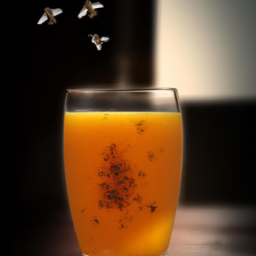
If you are someone who likes to start your day with a glass of orange juice, it is essential to be able to recognize when the juice has gone bad. Consuming expired orange juice can result in food poisoning and other health issues, so it is vital to know how to detect signs of spoiled juice.
In this article, I will guide you through the various signs to look out for when checking if your orange juice is still good for consumption. One of the main ways to determine if orange juice has gone bad is to check its expiration date. All packaged orange juice comes with an expiration date, which indicates the time by which the juice should be consumed.
However, expiration dates are not always accurate, and there are other signs to look out for to ensure that the juice is still drinkable. Knowing what to look for can help you avoid getting sick and ensure that you only consume fresh and safe orange juice.
Key Takeaways
- Checking expiration date and signs of spoilage is important to avoid health risks.
- Proper storage and pasteurization are crucial for quality and shelf life.
- Drinking spoiled juice can lead to health risks and bacterial growth.
- Proper disposal is necessary to prevent contamination and health hazards.
The Importance of Checking Expiration Dates
It’s crucial to always check expiration dates on orange juice to avoid potential health risks. Food safety should always be a top priority, especially when it comes to consumable products like orange juice.
Before purchasing or consuming orange juice, it’s important to take note of the expiration date listed on the label. Label reading is a key step in ensuring that the orange juice you’re buying is fresh and safe for consumption.
Expired orange juice can cause food poisoning or other health problems, so it’s important to always check the expiration date before consuming. Even if the orange juice still looks and smells fresh, consuming it past its expiration date can still be a risk.
After checking the expiration date, it’s also important to look for signs of mold or discoloration, as these can also indicate that the orange juice has gone bad.
With these precautions in mind, you can enjoy your orange juice without worrying about any potential health risks.
Look for Signs of Mold or Discoloration
Check for any visible signs of mold or discoloration on the orange juice container. If you see any, it’s time to toss it out before it makes you sick. Possible contamination can occur due to improper handling, storage, or pasteurization, which can lead to health risks such as food poisoning or infections. It’s essential to keep an eye out for any signs of spoilage before consuming the juice.
To help you identify a bad batch of orange juice, here’s a table outlining the visible signs of mold or discoloration to look out for:
| Visible Signs | Description | Action Needed |
|---|---|---|
| Mold | Fuzzy spots or powdery film on the surface or at the bottom | Discard the juice immediately |
| Discoloration | A change in color from bright orange to brown or black | Check for an off smell before consuming |
| Cloudiness or Separation | Murky appearance or separation of solids and liquids | Avoid consuming and discard the juice |
If you notice any of these visible signs of spoilage, it’s crucial to discard the juice immediately. However, even if you don’t see any mold or discoloration, it’s always best to check for an off smell before consuming the juice.
Check for an Off Smell
When you open the container of orange juice, take a deep sniff to detect any unusual odors that may resemble the smell of spoiled milk or rotten eggs. This is one of the most common ways to detect spoilage and potential health risks when consuming orange juice.
The off smell is usually caused by the growth of bacteria or yeast in the juice, which can happen due to improper storage, exposure to heat or light, or expired shelf life. Some common causes of off smelling orange juice are:
- Exposure to air – when the container is not sealed properly, oxygen can get in and cause the juice to spoil faster.
- Heat – leaving the juice in a warm environment can accelerate the growth of bacteria and yeast.
- Cross-contamination – using a dirty utensil or pouring the juice into a dirty glass can introduce harmful bacteria into the juice.
In the next section, we’ll discuss how to taste the juice to further confirm if it has gone bad.
Taste the Juice
Now, take a sip of that delicious orange juice and let your taste buds confirm its freshness! When it comes to determining juice quality, taste preferences play an important role. If you’re someone who enjoys the sweet tang of freshly squeezed oranges, you’ll know when you’ve got a bad batch on your hands.
The taste of spoiled juice is unmistakable – it’s sour, bitter, and leaves a strange aftertaste in your mouth. On the other hand, good orange juice should taste bright, refreshing, and sweet with just the right amount of tartness. In addition to taste, pay attention to the texture of the juice.
A bad batch of orange juice may also have a thick or slimy texture, which is a sign that the juice has started to ferment or spoil. If you notice any of these signs, it’s time to toss the juice and find a fresh bottle. But if your taste buds and texture checks confirm that the juice is good, then you’re in for a refreshing treat.
Now, let’s move on to the next step and observe the texture of the juice.
Observe the Texture
Take a closer look at the consistency of your orange juice and feel the smoothness against your tongue. Check for pulp consistency as well; if the juice seems too thick or has chunks floating in it, it may have gone bad.
Additionally, observe the color of the juice. If it appears darker than usual or has a brownish tint, it may have started to spoil.
Texture is an essential aspect to consider when determining if your orange juice has gone bad. If the liquid seems slimy or has a strange odor, it’s best to discard it immediately. However, if the juice appears fresh and has a smooth consistency, it may still be safe to consume.
Considering the storage conditions is the next step in ensuring that your orange juice is not spoiled.
Consider the Storage Conditions
Observing the texture of orange juice is a good start in determining whether or not it has gone bad, but it’s not enough to rely solely on this method.
Another important factor to consider is the proper storage of orange juice. Proper storage can greatly affect the quality and shelf life of the juice.
To ensure proper storage of orange juice, it’s important to keep it refrigerated and at a consistent temperature. The ideal temperature for orange juice is between 32-40°F. If the juice is left at room temperature for too long, it can spoil quickly and become unsafe to consume. It’s also important to keep the container tightly sealed to prevent any exposure to air or contaminants.
By properly storing orange juice, you can extend its shelf life and maintain its quality for a longer period of time. Knowing the shelf life of orange juice is also important in determining whether it has gone bad or not.
Know the Shelf Life of Orange Juice
Understanding the shelf life of orange juice is crucial for ensuring its quality and safety for consumption. The expiration date on the label is a good indicator of when the juice will go bad, but there are a few other factors to consider when determining the shelf life of orange juice.
Here are three things to keep in mind when understanding expiration and storing orange juice properly:
-
Once the container is opened, the shelf life decreases significantly. It’s recommended to consume the juice within 7-10 days after opening.
-
Keeping the orange juice refrigerated at all times can help extend its shelf life.
-
Avoid leaving the juice out for extended periods of time, as it can spoil quickly in warm temperatures.
Now that we have a better understanding of the shelf life of orange juice, it’s important to learn about pasteurization and its role in ensuring the safety and quality of orange juice.
Learn About Pasteurization
Let’s explore how pasteurization works to ensure the safety and quality of our beloved orange juice. Pasteurization is a process that involves heating the juice to a specific temperature and holding it there for a certain amount of time. This helps to kill any harmful bacteria that may be present in the juice, which can cause foodborne illness. The process is named after Louis Pasteur, the French microbiologist who discovered it in the 19th century.
Pasteurization has many benefits, including extending the shelf life of juice and preserving its nutritional value. However, it can also alter the taste and texture of the juice, which is why many people prefer fresh squeezed juice.
It’s important to note that not all orange juice is pasteurized, and those that are not may carry a higher risk of contamination. Understanding pasteurization is crucial in ensuring that we consume safe and healthy orange juice.
Let’s now move on to understand the risks of drinking spoiled juice.
Understand the Risks of Drinking Spoiled Juice
Be careful not to drink spoiled juice, as it can lead to health risks and bacterial growth. Here are some things to keep in mind:
-
Always check the expiration date before drinking juice. If the expiration date has passed, it’s best to dispose of the juice.
-
Look for signs of spoilage, such as a sour smell, off taste, or cloudy appearance. If you notice these signs, it’s best to err on the side of caution and throw the juice away. Additionally, check the expiration date and ensure the juice has been stored properly, as improper storage can accelerate spoilage. If you’re unsure *how to tell spoiled apple juice* apart from fresh juice, remember that any fizzy or bubbling texture is a clear indication that the juice has likely fermented. When in doubt, it’s always safest to discard questionable juice to avoid potential health risks.
-
Properly store juice in the refrigerator, and consume it within a few days of opening. Leaving juice out at room temperature for too long can encourage bacterial growth.
-
If you’re not sure if the juice is still good, it’s better to be safe than sorry and dispose of it.
-
If you do consume spoiled juice and experience symptoms such as nausea, vomiting, or diarrhea, seek medical attention immediately.
It’s important to properly dispose of spoiled juice to prevent any further health risks.
Properly Dispose of Spoiled Juice
Now that we’ve got a better understanding of the risks of drinking spoiled juice, it’s important to know how to properly dispose of it. Improper disposal can lead to health hazards, so it’s crucial to handle it with care.
The best way to dispose of spoiled juice is to pour it down the drain while running hot water. This will help to dilute the juice and prevent any bacteria from lingering in the pipes. Avoid pouring it in the sink without running water, as this can cause the bacteria to accumulate and potentially contaminate other surfaces.
Additionally, it’s important to properly clean any containers or utensils that may have come into contact with the spoiled juice to prevent cross-contamination.
By following these steps, you can safely and effectively dispose of spoiled juice and prevent any potential health hazards.
Frequently Asked Questions
How long does it take for orange juice to spoil?
To prolong the freshness of orange juice, store it in the refrigerator at 40°F or below. Once opened, consume within 7-10 days. Avoid exposing it to air and light which can cause spoilage.
Can you still drink orange juice if it’s past its expiration date?
I don’t recommend drinking orange juice past the expiration date. The flavor changes and it may not be safe to consume. Alternative uses include using it for cooking or as a cleaning agent.
What are the health risks of drinking spoiled orange juice?
Drinking spoiled orange juice can cause food poisoning, leading to symptoms like vomiting, diarrhea, and stomach cramps. To prevent this, store orange juice properly and discard it if it smells off.
Can you tell if orange juice is bad just by looking at it?
I can perform a taste test to determine if orange juice has gone bad. The shelf life of orange juice varies and is dependent on factors such as storage temperature and packaging.
How should you dispose of spoiled orange juice?
To properly dispose of spoiled orange juice, pour it down the drain while running hot water. This helps to prevent clogs and minimize environmental impact. It is important to not pour it onto the ground or in the trash.
Conclusion
In conclusion, it’s crucial to know how to identify spoiled orange juice in order to avoid the risks of consuming contaminated juice. Always check the expiration date and look for signs of mold, discoloration, and an off smell.
Additionally, tasting the juice and observing its texture can also give you a good indication of whether it has gone bad. It’s important to keep in mind the shelf life of orange juice, which can vary depending on the type of juice and how it’s processed.
Understanding the process of pasteurization can also help you make informed choices about the juice you consume. And if you do come across spoiled juice, it’s important to properly dispose of it to prevent any potential health hazards.
By staying informed and vigilant, you can ensure that you’re always enjoying safe and healthy orange juice.
Cindy thoroughly researches juicing trends, techniques, and recipes to provide readers with practical advice and inspiration. Her writing style is accessible, engaging, and designed to make complex concepts easy to understand. Cindy’s dedication to promoting the advantages of juicing shines through her work, empowering readers to make positive changes in their lives through the simple act of juicing.
-

 Popular Juice Brands4 weeks ago
Popular Juice Brands4 weeks ago10 Top-Rated Organic Juice Brands to Try
-

 Popular Juice Brands1 month ago
Popular Juice Brands1 month ago9 Best No-Sugar-Added Popular Juice Brands
-

 Health Benefits of Juice2 weeks ago
Health Benefits of Juice2 weeks agoHow Much Bottled Lemon Juice Equals 1 Lemon
-
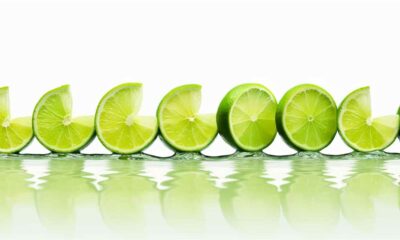
 Vegetable Juices4 weeks ago
Vegetable Juices4 weeks ago12 Top Organic Vegetable Juice Brands Reviewed
-

 Juice Tips and Tricks2 weeks ago
Juice Tips and Tricks2 weeks agoHow Long Does Lemon Juice Last After Expiration Date
-
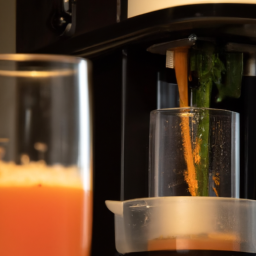
 Juice Tips and Tricks2 weeks ago
Juice Tips and Tricks2 weeks agoHow Long Does Juice Last After Juicing
-

 Juice Tips and Tricks2 weeks ago
Juice Tips and Tricks2 weeks ago2 Lemons Equal How Much Juice
-

 Vetted3 months ago
Vetted3 months ago15 Best Juices for Diabetics: Refreshing Options That Won’t Spike Your Blood Sugar




